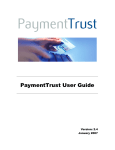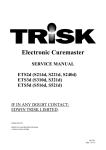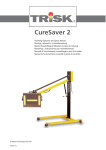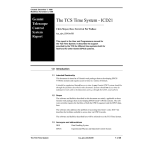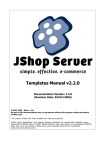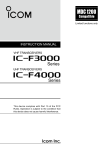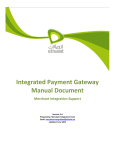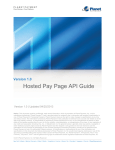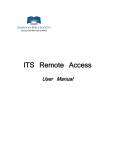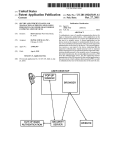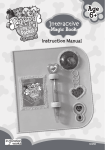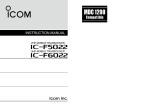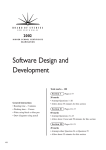Download Implementation Guide - High Capacity Gateway
Transcript
RiskGuardian & PaymentTrust – Implementation Guide Version: 2.0 April 2007 Copyrights Copyright 2006, PaymentTrust Limited. All rights reserved. Version 2.0 Issue Date: April 2007 Prepared by: PaymentTrust Ltd Trademarks Risk Guardian and PaymentTrust logo is trademark or service marks of Payment Trust Limited. All other marks listed in this document may be trademarks of their respective owners and are mentioned for identification purposes only. This User Manual is protested by the copyright laws and treaties and may not be reproduced without permission from PaymentTrust Limited. You may not use this guide to reverse engineer the PaymentTrust Limited PaymentTrust software. C ontents 1. Document Overview......................................................................................................... 1-1 1.1 1.2 1.3 1.4 PURPOSE OF THE DOCUMENT ................................................................................ 1-1 WHO SHOULD READ THIS DOCUMENT ................................................................... 1-1 TERMINOLOGY ....................................................................................................... 1-1 RELATED DOCUMENTS .......................................................................................... 1-2 2. Communication ................................................................................................................ 2-3 2.1 2.2 2.3 2.4 2.5 2.6 2.7 2.8 2.9 2.10 STLINK OVERVIEW ............................................................................................... 2-3 NETWORK LAYER .................................................................................................. 2-5 SECURITY LAYER ................................................................................................... 2-5 STLINK APPLICATION ........................................................................................... 2-5 NETWORK REQUIREMENTS ................................................................................... 2-6 EXAMPLE REQUEST (STN STRING)....................................................................... 2-7 EXAMPLE REQUEST (STN XML).......................................................................... 2-7 EXAMPLE XML WITH ESCAPING ........................................................................... 2-8 EXAMPLE HTTP POST REQUEST FOR STLINK ................................................... 2-8 EXAMPLE HTTP POST REQUEST FOR STLINK BATCH .................................... 2-8 3. RiskGuardian ................................................................................................................... 3-9 3.1 3.2 RISK GUARDIAN IMPLEMENTATION KEY STAGES ................................................. 3-9 LOGIC (TSCORE AND TRISK)............................................................................... 3-10 4. PaymentTrust ................................................................................................................. 4-11 4.1 4.2 4.3 4.4 4.5 4.6 4.7 WHAT IS PAYMENTTRUST? ................................................................................. 4-11 REQUESTYPES ...................................................................................................... 4-11 PAYMENTTRUST IMPLEMENTATION KEY STAGES .............................................. 4-12 METHOD OF PAYMENTS (MOP’S)....................................................................... 4-12 STOREIDS ............................................................................................................. 4-13 THE DIFFERENCES WITH DOMESTIC MAESTRO AND SOLO ............................... 4-14 RESPONSE CODES................................................................................................. 4-14 5. 3DSecure with PaymentTrust ....................................................................................... 5-17 5.1 WHAT IS 3DSCECURE? ........................................................................................ 5-17 A TYPICAL 3DSECURE TRANSACTION USING PAYMENTTRUST’S HOSTED MPI........ 5-17 5.2 MERCHANT APPLICATION REQUESTS VIA STLINK FOR 3D SECURE ENROLMENT VERIFICATION. (REQUESTYPE V) ................................................................................. 5-17 5.3 ENROLMENT RESPONSE CONTAINS CUSTOMERS ISSUING BANK URL. THE MERCHANT APPLICATION INSTRUCTS CUSTOMER’ S BROWSER TO REDIRECT TO THE PROVIDED URL. ............................................................................................................ 5-18 5.4 BROWSER REDIRECTS TO CUSTOMER’S ISSUING BANK URL INCLUDING THE TERMURL AND MD FIELDS. CUSTOMERS ATTEMPT TO AUTHENTICATE THEMSELVES BY ANSWERING THEIR CHALLENGE QUESTION OR ENTERING THEIR PIN .......................... 5-19 5.5 AUTHENTICATION RESULT IS POSTED BACK TO MERCHANT’S COMMERCE APPLICATION. ................................................................................................................ 5-20 5.6 MERCHANT’S APPLICATION REQUESTS VIA STLINK FOR VALIDITY OF THE AUTHENTICATION RESPONSE. (REQUESTYPE A).......................................................... 5-20 5.7 MERCHANT’S APPLICATION PREPARES A STANDARD AUTH/SALE WITH PROVIDED 3D SECURE FIELDS: ECI, CAV, SECUREID AND SENDS A REQUEST TO STLINK. ....... 5-22 5.8 A RECEIPT PAGE IS RETURNED TO THE CUSTOMER WITH ACCEPTED OR DECLINED MESSAGE. ....................................................................................................................... 5-24 6. Bank Indentification Table (BIN) Table ...................................................................... 6-25 6.1 6.2 SCREENSHOT OF DATA (CSV FORMAT) ................................................................ 6-25 SCREENSHOT OF DATA (TXT FORMAT) ................................................................ 6-26 7. URL’s and Tools............................................................................................................. 7-27 ALL TEST AND LIVE TRANSACTION SYSTEM ................................................................ 7-27 RG TEST WEBSITE ......................................................................................................... 7-27 PT TEST WEBSITE.......................................................................................................... 7-27 8. 9. 10. 11. 12. 13. 14. 15. 16. 17. Appendix I – RG Set-up Form...................................................................................... 8-28 Appendix II – PayBack (Credit Card) Set-up Form................................................... 9-36 Appendix III – PT Acquiring Set-up Form ............................................................... 10-37 Appendix IV – Domestic Maestro and Solo Bins ...................................................... 11-38 Appendix V: message/response codes......................................................................... 12-41 Appendix VI: currency codes...................................................................................... 13-48 Appendix VII: country codes ...................................................................................... 14-50 Appendix VIII: state/province/region codes .............................................................. 15-56 Appendix IX: how to contact us.................................................................................. 16-59 Glossary of payment processing terminology............................................................ 17-60 1. DOCUMENT OVERVIEW 1.1 Purpose of the Document This document provides an overview of how to implement PaymentTrust’s core services, Risk Guardian and PaymentTrust. Additionally to this there are subsequent documents listed below covering our Payback services and Bank Transfer Service these documents should be read in conjunction with this when implementing these services. The Developer’s guide is the main document for understanding message formats and communication methods. 1.2 Who should read this document System Integrators and Project Managers responsible for implementing PaymentTrust’s products and services. 1.3 Terminology The following is a glossary of terms and abbreviations used in this document: Term or Abbreviation PT: STLink: STN: Definition PaymentTrust PaymentTrust’s Secure Transaction Link PaymentTrust’s Secure Transaction Network SSL: Secure Sockets Layer API: Application Program Interface ASP: Active Server Pages CGI: Common Gateway Interface VPN: Virtual Private Network RG -RM: PT -PP: Transaction Services Merchant RiskGuardian - Risk Management PaymentTrust - Payment Processing Includes PaymentTrust (PT), RiskGuardian (RG), Bins (BN), Bank Transfer Service (BT), Foreign Exchange (FX), 3DSecure (3D) and others. PaymentTrust Client 1-1 1.4 Related Documents All Integration related documents can be downloaded from the following URL. http://www.paymenttrust.ca/devtools/ PaymentTrust User Guide - PaymentTrust User Guide 2.4.pdf RiskGuardian User Guide - RiskGuardian User Guide 3.0.pdf Developer’s Guide - MerchantServices-DevGuide-08.20.00.doc 3DSecure Flow Chart - Hosted_MPI_Flow_002 dec06.doc.doc 1-2 2. COMMUNICATION The PaymentTrust Secure Transaction Network (STN) is a collection of robust, multithreaded and real-time transaction systems (See Figure 1 below). STN is composed of the PaymentTrust Secure Transaction Link (STLink) system and back-end Transaction Services. STLink receives transaction information from merchants, processes the information through one of the many transaction services, and sends the response back to the merchant’s requesting system. All Internet communication mentioned in this document is executed via an Internet 128 bit Secure Sockets Layer (SSL) connection, or an Internet Virtual Private Network (VPN) connection using the Triple DES standard. Fig 1: Overview of PaymentTrust’s Secure Transaction Network 2.1 STLink Overview PaymentTrust’s Secure Transaction Link (STLink) is a high performance communication solution. STLink is a service of on-demand secure communication links between the PaymentTrust Secure Transaction Network (STN) and a PaymentTrust Client (Merchant). STLink conforms to encryption and protocol standards as described below (See Figure 2 for network implementation). Transactions sent between a PaymentTrust Merchant and the PaymentTrust STN travel securely via a 128-bit SSL Internet connection. The STLink system also allows for a hardware encryption method/solution using VPN technology & IPSEC standards. The Merchant’s own application will reside on his system and will be accessible via major web servers, Transaction platforms, and back-end systems. Merchants will be using PaymentTrust’s technical specs as guidance to develop their own applications. PaymentTrust provides Merchants example code in ASP/VB, C++, Java, HTML and 2-3 XML. Merchants may choose to use their own samples and applications to send transaction information but must conform to the string requirements set in this document. Fig 2: Overview of Network Implementation Possibilities The STN is comprised of three layers. Descriptions of these layers can be found below in Figure 3. Authentication Communication STlink within STN TM Access Security SSL / VPN (Cryptography) Network TCP/IP (Internet) * Platform Independent Fig. 3 TM Secure Transaction Services Network - Communication Protocol Layers 2-4 2.2 Network Layer This layer is handled exclusively by the designated Internet Service Provider. 2.3 Security Layer The Security Layer will be handled either by 128 bit SSL certificate or a secure tunnel Triple DES VPN conforming to the IPSEC standard. PaymentTrust will provide at an additional cost the VPN hardware equipment if required. The Security Layer also includes the Merchant access layer into the PaymentTrust Secure Transaction Network (STN). This involves the use of a Merchant ID, a Username and Password, which are sent as a string to STLink. 2.4 STLink Application The Application Layer manipulates data using HTTP(S) GET/POST request or an XML request and communicates via standard ports 443 for SSL or port 80 for VPN. The system can intelligently process a request whether GET/POST or XML. The request (an input string) is routed with the STN to the appropriate service for processing – PT, RG, and others. The system returns the response to the requesting URL. Should the delivery fail, the system will capture the error, inform the merchant and store the information for later reporting. Captured errors are further analyzed. When the delivery is successful, the merchant receives a response and stamps each transaction with an appropriate message code. Please note that for larger strings sizes the GET method should not be used. The input string/message sent by the Merchant is stored in a serialised database with a unique serial number. PaymentTrust maintains a log of any transaction requested by the Merchant and responds with a real-time message which will encapsulate information regarding: Integrity of the message sent by the Merchant – if a message is received truncated/ incomplete or in a tampered condition, the STLink application will capture the error and will respond with the appropriate error message to the merchant’s system; Authentication of sending and receiving agents (attributes that assure a given request is received from a specific trading partner) – messages between Merchant and PaymentTrust must contain attributes that identify and recognize a specific Merchant; The Type of Transaction requested along with processing statistics. I.e. an RG transaction that took 2 seconds to process from IP NNN.NNN.NNN.NNN using SSL etc. It must be noted that the STLink system is Payload independent – data within the communication link is independent and can accommodate any type of Transaction, for example, an RG transaction with the same ease as a PT transaction. This eases the transition when new services become available. The STLink system is based on HTTP/1.1 as a transport protocol as well as XML 1.0. It uses generic protocols for communication between user agents and proxies/gateways and other Internet systems. Communication between a PaymentTrust Merchant and a PaymentTrust STN will be achieved through request 2-5 messages and response messages. The STLink system implements and exploits the advantages provided by HTTP(S) and XML. 2.5 Network Requirements The following is required prior to testing of the STN and STLink system by Merchants. Internet access or dedicated link into the TMI Secure Transaction Network The originating external IPs if SSL is used or the internal IP addresses of the computers that will participate in the VPN, as well as the external IP it will use. Name and phone number of the designated technician or administrator responsible for the integration process. Notification when the testing process is complete. Our Network Operations Team will at that point take over of the process. The Merchant will receive the following items from TMI: VPN hardware if this is the solution chosen. SSL URL if SSL is chosen (High Encryption Pack). A merchant must follow a few simple steps to send transactions to the STN. 1. Build the HTTP headers 2. Build the transaction data. 3. Encode the transaction data. 4. Attach the transaction data to the HTTP headers. 5. Open a TCP/IP connection to STN. 6. Establish secure communication to STN using SSL. 7. Send the HTTP request to STN. 8. Receive HTTP response with transaction result from STN. All transaction requests must be submitted to STLink and all batch requests to STLink Batch in either the STN’s string format or as XML documents. Both STLink and STLink Batch accept the HTTP and HTTPS protocols, though it is recommended that the HTTPS protocol be used to safely transmit the requests via the Internet. HTTP is the message protocol used to make request to the STN servers. HTTPS refers to the fact that the HTTP request is done over an encrypted/secure network connection. The HTTP header should consist of the request method (POST), the requested resource (STLink), the HTTP version (1.1), a new line, the amount of data being posted (Content-Length) and 2 new lines. The 2 new lines at the end of the header allow the separation of the HTTP header from the data being posted. All requests must be submitted using the HTTP POST method. The POST method works by supplying key/value pairs, where the key and value are split by the “=” 2-6 symbol and key/value pairs by the “&” symbol. For instance: key1=some value&key2=some value... In the case of STLink, there is one key value pair. The key is StringIn and the value is any of TMI transaction types. The POST data is always attached to the HTTP header after 2 new lines “\n”. An additional 2 new lines must be appended after the POST data to terminate the HTTP request as a whole. 2.6 Example Request (STN String) This string demonstrates the key value pair of a POST request and contains the data of a partial transaction. StringIn=VersionUsed^1~MerchantId^100000~UserName^Mariah~UserPassword^rr 87uy~TransactionType^A~IsTest^1~TimeOut^90000~ 2.7 Example Request (STN XML) This XML document demonstrates the key value pair of a POST request and contains the data of a partial transaction. StringIn=<?xml version=”1.0”?><TMSTN><VersionUsed>1</VersionUsed><MerchantId>100000</ MerchantId><UserName>Mariah</UserName><UserPassword>rr87uy</UserPasswo rd><TransactionType>A</TransactionType><IsTest>1</IsTest><TimeOut>90000</ TimeOut></TMSTN> Though STLink Batch accepts POST requests, it is important to note that the StringIn key is not required and must not be submitted to the STLink Batch for batch requests. If not the batch request will be rejected for reason of being a malformed XML document. The “=” and “&” symbols are standard characters used in the HTTP protocol to separate key/value pairs, there fore it is important that no “=” and “&” symbols be found in the transactions, although this can be overcome by escaping all characters after the StringIn key by using URL encoding. URL encoding allows the “=”, “&” and other HTTP characters to be included in the transaction. Example: StringIn=<URL encoded transaction> Because STLink Batch does use the StringIn key, the batch request must not be URL encoded. If not the batch request will be rejected for reason of being a malformed XML document. XML has its own encoding rules. For one, the STLink and STLink Batch will support any XML document that has been encoded in an 8-bit ANSI character set, such as: ISO-8859-1. Second of all XML has its own share of “special” characters. If any of these characters are to be included within the data of a specified transaction tag, they to must be escaped. The table below lists those characters and their escape sequence. 2-7 Character Description Escape Sequence < Less than < > Greater than > & Ampersand & ‘ Single quote ' “ Double quote " 2.8 Example XML with escaping <?xml version=”1.0”?> <root> <tag1>The text in here contains a less than symbol. Here it is: <</tag1> <tag2>The text in here contains a double quote symbol. Here it is: "</tag2> </root> 2.9 Example HTTP POST request for STLink This shows what an HTTP request to Stlink should be, using the following STN URL: https://stn01.sectranet.com/stlinkssl/stlink.dll. \n depicts a new line. The content length is the total amount of bytes including the key pair and the URLEncoded data. POST /stlinkssl/stlink.dll HTTP/1.1\n Content-Length: 123456\n \n StringIn=<URL encoded string or XML document>\n \n 2.10 Example HTTP POST request for STLink Batch This shows what an HTTP request to Stlink Batch should be, using the following STN URL: https://stn01.sectranet.com/stlinkssl/stlink.dll. \n depicts a new line. The content length is the total amount of bytes the XML document. POST /stlinkssl/stlinkbatch.dll HTTP/1.1\n Content-Length: 123456\n \n <XML document with no URLencoding>\n \n 2-8 3. RISKGUARDIAN RiskGuardian is a secure risk management solution that allows merchants to securely manage the risk associated with doing business on the Internet. RiskGuardian provides a set of static risk factors, determined by TMI, and a set of customizable risk factors, which the merchant can alter to manage their risk on an individual basis. RG Features: • Provides risk management and assessment for online transactions • Total overhead is less than three seconds • Merchant controlled parameters and values • Online reporting and administration tools • Export and Import capabilities for mass updates • Focused on identity theft through Internet aware as well as traditional parameters • Over 60 parameters and 300 algorithms and cross checks performed 3.1 Risk Guardian Implementation key stages Technical evaluation Understanding our API and what impact it will have on your system Development Actual coding based on API and system changes required. Profiling Understanding the merchant’s requirements in terms of blocking lists, previous fraud etc etc. Appendix X is the set-up form for RG where most of this information is obtained. Testing Full end to end testing of your application. Fine Tuning Sending live data to the Risk Guardian test system for the initial 2 weeks, in order that the risk profile previously completed is 100% in line with the Merchant’s requirements. Please note, this is still testing and the logic talked about earlier in this document should be ignored until go-live. Basically, the merchant should not act upon the TScore’s until profiling is complete. Go-live…. 3-9 3.2 Logic (Tscore and TRisk) Risk Guardian is works on a scoring basis, 1 meaning an instant pass and 100 meaning an instant failure. Enclosed is a sample transaction. Request StringIn=VersionUsed^3~MerchantId^100162~OrderNumber^HelpDeskTest~Typeof Sale^H~TransactionType^RG~IsTest^1~TimeOut^90000~UserName^umberdella~Us erPassword^della~AcctName^Eric Smith~MOP^CC~AcctNumber^4000000000000002~ExpDate^092002~CurrencyId^1 24~Amount^56.78~Title^Mr.~FirstName^Eric~MiddleName^~LastName^Smith~Suf fix^3rd~Address1^2130 Gold~Address2^Suite 101~Address3^~City^Chicago~StateCode^il~ZipCode^123456789~CountryCode^us~PhoneNumber^6188565656~Email^[email protected]~ShipTo Title^Mr.~ShipToFirstName^Eric~ShipToMiddleName^~ShipToLastName^Smith~S hipToSuffix^3rd~ShipToAddress1^123 Road~ShipToAddress2^~ShipToAddress3^~ShipToCity^Seattle~ShipToStateCode^ wa~ShipToZipCode^345678907~ShipToCountryCode^us~ShipToPhoneNumber^6188565656~REMOTE_ADD R^205.188.146.23~HTTP_USER_AGENT^MSIE 5.0;Windows NT~HTTP_ACCEPT_LANGUAGE^en,fr-CA~HTTP_ACCEPT_CHARSET^iso8859-1,*,utf-8~HTTP_REFERER^www.cnn.com~IsMember^3 Response MerchantId^100162~TransactionType^RG~OrderNumber^HelpDeskTest~StrId^1780 431~MessageCode^100~GttId^1329853~tScore^100.0000~tRisk^56 This transaction scored 100 because the card number is invalid. Please note that transactions can score for a number of reasons i.e. cross reference or velocity controls. Simply if the TScore is Greater than the TRisk then the transaction had failed your risk profile and shouldn’t be processed. By default, if the TScore is equal to or Lower that the TRisk then the transaction should proceed for processing with the acquiring bank either via PaymentTrust or another Payment Processor. 3-10 4. PAYMENTTRUST 4.1 What is PaymentTrust? PaymentTrust is capable of receiving multiple request types within the PT Transaction Type. Each request type instructs the system to perform a different financial transaction. It is important to note that all requests types must follow a logical sequence so prior to a Deposit request one must have an Authorization request. There are cases where the PT TRX is an independent TRX not requiring any other Request type such in the case of a payback TRX or Bank Transfer. Following the submission of a request, the system will return an appropriate response code that will flag the transaction as being either successful, unsuccessful (with reason) or pending (awaiting third party confirmation). Each numeric response code is accompanied by a text definition. 4.2 Requestypes An Authorization (A) request will reduce the cardholder’s open to buy (credit limit). It places a hold on the funds for the merchant with the cardholder’s bank for a limited period of time (defined by the credit card associations) before it expires. An authorization does not move any funds to the merchant’s bank account. A deposit request type is required to initiate fund collection and is described below. A Settlement (D) request marks a previously authorized transaction for funds collection during the next deposit cycle with the financial institution. Merchants who do not ship goods immediately should only perform this transaction request at the order fulfillment stage (shipment). Important Note: A merchant can only submit one deposit request per authorization and this must be for a value lesser or equal to the authorized amount. A Refund (R) request returns a specified amount to the cardholder’s account. The following refund is submitted where a previous deposit transaction has been processed by the system. Please note that refunds for gaming clients as part of the Visa Credit Funds Transfer programme (CFT) must be sent to PaymentTrust as ‘Forced Refunds’. Details of this Transaction can be found in the Developer’s Guide V8.0.16 page 31. A Simultaneous Authorization and Settlement (S) charges the specified amount against the cardholder’s account and marks the transaction for funds collection during the next deposit cycle with the financial institution. This single request initiates both an authorization and a deposit request in the PT system. It should only be used in situations where merchants fulfil their orders immediately. The deposit portion of the ‘S’ request will only proceed once a successful authorization has been obtained. A Cancellation (C) - Any transaction that is showing 2050 – request pending can be cancelled. A Payback (P) request has three methods; 4-11 1. Credit card This is a payment going back to a Credit Card Issuer, quoting the full card number as a reference and is only available to UK issued Mastercard and Visa. Payments are made via BACS Ltd in the UK. 2. Physical Cheque This is a physical cheque being sent out to the recipient via the conventional post or via courier. 3. Electronic Credit This is an Electronic payment going back directly to a Clients bank account. A document entitled ‘Payback Service Overview’ is available on request which cover the payback service in detail. A Bank Transfer (B) a document entitled ‘Bank Transfer Service Overview’ is also available on request. 4.3 PaymentTrust Implementation key stages Technical evaluation Understanding our API and what impact it will have on your system. Development Actual coding based on API and system changes required. Testing Full application end to end testing. Live bank set-up Merchant account details are given to the merchant by the Acquiring Bank based on Currency, transaction type, channel (Internet, Moto, digital TV etc ), these details are entered into the PaymentTrust live back end systems. Terminal ID’s are allocated by PaymentTrust and sent to the Acquiring bank for set-up on their live systems. Once the details are active on both systems then everything is ready and go-live can commence. Go-live…. 4.4 Method of Payments (MOP’s) • • • • • • • • CC – Visa and Mastercard credit and debit products (visa credit, visa delta, visa electron, Mastercard Credit, International Maestro) DS – Domestic Maestro and Solo CQ – Payback via Cheque EC – Payback via Electronic Credit NT – Neteller P2 – Pay2 DC – PIN enabled debit cards PC – Purchasing cards 4-12 4.5 StoreIDs Storeid is mandatory for all TransactionType^PT~. The Storeid is the same number as the Acquiring bank MerchantID. This is required in each transaction in order that PaymentTrust can settle into the correct currency account with the bank. Typical set-up with Natwest Streamline, E-commerce sales MerchantID/StoreID 64383638 Currency Australian Dollars Currency Australian Dollars Moto sales MerchantID/StoreID 52722722 Danish Kroner 81524262 Danish Kroner 26242846 Euro 76494332 Euro 47383563 Euro - Laser Card 42524262 Euro - Laser Card 13252322 Swedish Kronor 22840507 Swedish Kronor 46474647 Swiss Franc's 79585958 Swiss Franc's 53735373 Taiwanese New Dollar (settle in GBP) Thai Baht 63734324 72537363 13538292 Taiwanese New Dollar (settle in GBP) Thai Baht US Dollars 26836383 US Dollars 83638251 12154121 British Pounds British Pounds E-commerce Refunds Currency Australian Dollars MerchantID/StoreID 63836383 93739383 23262028 Moto refunds Currency Australian Dollars MerchantID/StoreID 75857575 Danish Kroner 74846384 Danish Kroner 63736373 Euro 84747498 Euro 98765454 Euro - Laser Card 63736387 Euro - Laser Card 34542872 Hong Kong Dollars 75957595 Hong Kong Dollars 53635396 Swedish Kronor 74948494 Swedish Kronor 25262522 Swiss Franc's 51625171 Swiss Franc's 86323242 Taiwanese New Dollar (settle in GBP) Thai Baht 76584575 12415161 62826282 Taiwanese New Dollar (settle in GBP) Thai Baht US Dollars 84374847 US Dollars 56252425 British Pounds 23241911 British Pounds 25262526 86785744 Typical set-up with Barclaycard Merchant Services, 5464543 3637363 3738373 8474847 Sterling sales Sterling refunds Multi Currency Sales Multi currency refunds Storeid’s for all payback requests is the same as the PaymentTrust Merchant ID ie 100625. 4-13 4.6 The Differences with Domestic Maestro and Solo All Payment Transactions are relevant for switch and solo - Authorisation, Sale, Forced Refund. The difference here is the MOP = DS, the Issuenumber and Startdate. Following fields become mandatory for switch and solo transactions along with all other fields (See the API document for full detailed table); Dat a Siz e 2 Field Name Data Type MOP Alpha Issuenumber Numeric 2 Startdate Numeric 6 Description ‘DS' for Switch/Solo debit cards Issue number stands for the number of cards issued on that bank account. Maximum of 2 digits. The number can be any number between 1 and 99, however normally it's between 1 and 10. Example “092003” The additional error codes for switch and solo are; 2280 Incorrect start date congratulations 2282 Invalid issue number Please note that all switch and solo transaction have to be sent in GBP sterling currency only. CurrencyID = 826. ‘Appendix D’ shows which switch/ solo card range need an issue number or a start date to process a transaction. 4.7 Response Codes A full list of response codes can be found in the Developer’s guide. Enclosed here is a list of the common response codes. Payment processing with acquiring bank (Streamline and Barclays) 2100 – Transaction Approved 2200 - Transaction Declined 2958 – Call Acquirer/Issuer 2614 - Acquirer/Issuer Unavailable 2210 – Invalid Credit card number 2212 – Card expired 2644 – Insufficient Terminal ID’s Payback – Credit card 2050 – Request pending (successfully processed, will be processed in next batch) 2223 – No sort code and account number in the payback system 4-14 2219 – Not supported the card number is non UK Please note, for transactions that go on-line in the case of RequestType’s A’s and S’s, if successful the transactions will received a response code 2100 transaction approved. This is also the case for Switch/Solo refunds. For transactions which are batched and processed at a later time, like refunds R’s or payback P’s then a successful response is 2050 – request pending. Switch Refund request example; Request StringIn=VersionUsed^1~MerchantId^100625~TransactionType^PT~IsTest^1~Type ofSale^S~TimeOut^90~UserName^TMISUPPORT~UserPassword^tmisupport~Acct Name^Alex~MOP^DS~AcctNumber^4936540000400016~ExpDate^122002~Curren cyId^826~Amount^1.00~RequestType^R~issuenumber^1~ Response MerchantId^100625~TransactionType^PT~OrderNumber^5209075289~StrId^82744 20~PTTID^10414920~MOP^DS~CurrencyId^826~Amount^1.00~AuthCode^B01637 ~RequestType^R~MessageCode^2100~Message^Transaction Approved Visa card Refund request example; Request StringIn=VersionUsed^1~MerchantId^100625~TransactionType^PT~IsTest^1~Type ofSale^S~TimeOut^90~UserName^TMISUPPORT~UserPassword^tmisupport~Acct Name^Alex~MOP^cc~AcctNumber^4779160330716625~ExpDate^122005~Currenc yId^826~Amount^1.00~RequestType^R~ Response MerchantId^100625~TransactionType^PT~OrderNumber^536177545~StrId^827448 2~PTTID^10414921~MOP^CC~CurrencyId^826~Amount^1.00~RequestType^R~M essageCode^2050~Message^Request pending Visa card Authorisation request example; Request StringIn=VersionUsed^1~MerchantId^100625~TransactionType^PT~IsTest^1~Type ofSale^S~TimeOut^90~UserName^TMISUPPORT~UserPassword^tmisupport~Acct Name^Alex~MOP^cc~AcctNumber^4779160330716625~ExpDate^122005~Currenc yId^826~Amount^1.00~RequestType^A~ Response MerchantId^100625~TransactionType^PT~OrderNumber^7470534577~StrId^82745 42~PTTID^10414923~MOP^CC~CurrencyId^826~Amount^1.00~AuthCode^B0466 F~RequestType^A~MessageCode^2100~Message^Transaction Approved MasterCard Payback request example; Request 4-15 StringIn=VersionUsed^1~MerchantId^100625~TransactionType^PT~IsTest^1~Type ofSale^S~TimeOut^90~UserName^TMISUPPORT~UserPassword^tmisupport~Acct Name^Alex~MOP^cc~AcctNumber^5301207010000012~ExpDate^122005~Currenc yId^826~Amount^1.00~RequestType^P~Storeid^100625~ Response MerchantId^100625~TransactionType^PT~OrderNumber^637464746~StrId^827448 2~PTTID^10414967~MOP^CC~CurrencyId^826~Amount^1.00~RequestType^R~M essageCode^2050~Message^Request pending 4-16 5. 3DSECURE WITH PAYMENTTRUST 5.1 What is 3DSecure? 3DSecure enables cardholders to authenticate themselves to their issuers through the use of a unique, personal code. It’s an industry wide initiative that is being undertaken in order to address current consumer concerns about security of online shopping. This includes Verified By Visa and MasterCard Secure Code. A Typical 3DSecure Transaction using PaymentTrust’s Hosted MPI Customer confirms his purchase. A form is posted to the merchant’s commerce application (php, asp, jsp, cold fusion etc.) 5.2 Merchant application requests via STLink for 3D Secure enrolment verification. (RequesType V) Customer Browser Customer's Bank INTERNET STLink 2 a. 1 Merchant Commerce Application If enrolment response is successful (CHEnrolled = Y). See Step 5.3. 5-17 b. If enrolment verification failed based on the 3D Secure CHEnrolled value, the merchant sends an authorization as follows. CHEnrolled VISA MasterCard N Merchant sends authorization request with 3D Secure fields. Merchant sends authorization request with 3D Secure fields. ECI: 06 ECI: N/A CAV: N/A. CAV: N/A. SecureId: SecureId submitted to MPI during enrolment verification. SecureId: SecureId submitted to MPI during enrolment verification. See Step 5.8. See Step 5.8. Merchant sends authorization request with 3D Secure fields. Merchant sends authorization request with 3D Secure fields. ECI: 07 ECI: N/A CAV: N/A. CAV: N/A. SecureId: SecureId submitted to MPI during enrolment verification. SecureId: SecureId submitted to MPI during enrolment verification. See Step 5.8. See Step 5.8. Merchant can decide to send authorization request with 3D Secure fields. Merchant can decide to send authorization request with 3D Secure fields. ECI: 07 ECI: N/A CAV: N/A. CAV: N/A. SecureId: SecureId submitted to MPI during enrolment verification. SecureId: SecureId submitted to MPI during enrolment verification. See Step 5.8. See Step 5.8. U N/A 5.3 Enrolment response contains customers issuing bank URL. The merchant application instructs customer’s browser to redirect to the provided URL. Note 1: This is typically done through hidden form fields and JavaScript that automatically posts the form to the bank URL. Note 2: The merchant session is re-established as follows. When the merchant application instructs the browser to redirect, there are 2 hidden form fields TermUrl and MD (Merchant Data). The TermUrl tells the issuing bank where to POST back the results. The MD field may contain any value the merchant may require to establish back the session. Before placing any sensitive data in the MD field it must be encrypted. 5-18 Customer Browser Customer's Bank INTERNET 1 3 Merchant Commerce Application STLink 2 See Step 5.4. 5.4 Browser redirects to customer’s issuing bank URL including the TermUrl and MD fields. Customers attempt to authenticate themselves by answering their challenge question or entering their pin Customer Browser Customer's Bank 4 INTERNET STLink 2 1 3 Merchant Commerce Application See Step 5.5. 5-19 5.5 Authentication result is posted back to merchant’s commerce application. Note 1: In Step 5.3, one of the hidden form fields (TermUrl) contains a merchant assigned URL that is used to receive the authentication response. Note 2: The MD field will also be posted back as a hidden form field. This is the data the merchant opted to include during Step 5.3. Customer Browser Customer's Bank 4 INTERNET STLink 2 1 3 5 Merchant Commerce Application See Step 5.6. 5.6 Merchant’s application requests via STLink for validity of the authentication response. (RequesType A) a) If authentication succeeded (customer answered challenge correctly). See Step 5.7. b) If authentication failed based on the 3D Secure TXStatus value, the merchant may be able to send an authorization. 5-20 Customer Browser Customer's Bank 4 INTERNET STLink 2 6 1 3 5 Merchant Commerce Application 5-21 TXStatus VISA MasterCard N Merchant must not send authorization and decline customer’s purchase. Merchant must not send authorization and decline customer’s purchase. See Step 5.8. See Step 5.8. Merchant sends authorization request with 3D Secure fields. Merchant sends authorization request with 3D Secure fields. ECI: 06 ECI: 01 CAV: Send if available. CAV: Send if available. SecureId: SecureId submitted to MPI during enrolment verification. SecureId: SecureId submitted to MPI during enrolment verification. See Step 5.8. See Step 5.8. Merchant can decide to send authorization. Merchant can decide to send authorization. ECI: 07 ECI: N/A CAV: N/A. CAV: N/A. SecureId: SecureId submitted to MPI during enrolment verification. SecureId: SecureId submitted to MPI during enrolment verification. See Step 5.8. See Step 5.8. Merchant must not send authorization and decline customer’s purchase. Merchant must not send authorization and decline customer’s purchase. See Step 5.8. See Step 5.8. A U N/A 5.7 Merchant’s application prepares a standard auth/sale with provided 3D Secure fields: ECI, CAV, SecureId and sends a request to STLink. 5-22 Customer Browser Customer's Bank 4 INTERNET 2 STLink 6 1 3 5 Merchant Commerce Application 7 TXStatus VISA MasterCard Y Merchant sends authorization request with 3D Secure fields. Merchant sends authorization request with 3D Secure fields. ECI: 05 ECI: 02 CAV: Send if available. CAV: Send if available. SecureId: SecureId submitted to MPI during enrolment verification. SecureId: SecureId submitted to MPI during enrolment verification. See Step 8. See Step 8. 5-23 5.8 A receipt page is returned to the customer with accepted or declined message. Customer Browser Customer's Bank 4 INTERNET 2 STLink 6 1 3 5 8 Merchant Commerce Application 7 5-24 6. BANK IDENTIFICATION TABLE (BIN) TABLE To down load the latest BIN table go to the following URL https://www.trustmarque.ca/Paymenttrust1.2-Live/BINSDownload/ And type in the username and password (If asked), below; Username: support Password:tmicsupport Right click on tmibin.csv A pop up window appears click on save Change the file extension from csv to txt and then click save to your desired location. It will take approximately 4 minutes to download and will be a 7 MB file. The BIN table may be downloaded as often as required. PaymentTrust will update the table weekly on a Wednesday, at 8.00am GMT. PaymentTrust will erase all BINs on this day and upload the new table from NatWest. Therefore there is no update just a complete replace. 6.1 Screenshot of data (csv format) Below is a screenshot showing the fields of data provided. The list is CardBIN1, CardBin2, CardName, CardType and CountryCode. 6-25 6.2 Screenshot of data (txt format) 6-26 7. URL’S AND TOOLS All Test and Live transaction system Primary https://stn01.sectranet.com/stlinkssl/stlink.dll? https://stn01.sectranet.com/stlinkssl/stlinkbatch.dll? (Batch) Secondary https://stl007.kontek.cc/stlinkssl/stlink.dll? https://stl007.kontek.cc/stlinkssl/stlinkbatch.dll? (Batch) RG Test website https://merchantadmin.riskguardian.com/test/ PT Test website https://merchantadmin.paymenttrust.com/test/ 7-27 8. APPENDIX I – RG SET-UP FORM PaymentTrust Ltd Sales Representative PaymentTrust Ltd Identifier (PTMID) Date Product Profile: What products are sold? Do you provide hard, digital or service goods? Please provide details of accepted currencies and associated values. Currency: Avg Sale Highest Sale Lowest Sale Are the majority of sales to male or females? How often will a consumer buy on average? Do you require the consumer to register? Will registration i.e. length of membership be passed to RG? Do you require consumers to use a wallet/account? 8-28 How long does it take to refill the wallet/account: Have you experienced any fraud problems? Please provide details below Country Algeria American Samoa Andorra Angola Anguilla Antarctica Antigua and Barbuda Argentina Armenia Aruba Australia Austria Azerbaijan Bahamas Bahrain Bangladesh Barbados Belarus Belgium Belize Benin Bermuda Bhutan Bolivia Bosnia and Herzegovina Botswana Bouvet Island Which Country Code countries do you sell to? Which countries do you not wish to sell to? Which countries have you experienced problems? DZ AS AD AO AI AQ AG AR AM AW AU AT AZ BS BH BD BB BY BE BZ BJ BM BT BO BA BW BV 8-29 Brazil British Indian Ocean Territory Brunei Darussalam Bulgaria Burkina Faso Burundi Cambodia Cameroon Canada Cape Verde Cayman Islands Central African Republic Chad Chile China Christmas Island (Australia) Cocos (Keeling) Islands Colombia Comoros Congo Cook Islands Costa Rica Cote D'Ivoire (Ivory Coast) Croatia (Hrvatska) Cuba Cyprus Czech Republic Denmark Djibouti Dominica Dominican Republic BR IO BN BG BF BI KH CM CA CV KY CF TD CL CN CX CC CO KM CG CK CR CI HR CU CY CZ DK DJ DM DO 8-30 East Timor Ecuador Egypt El Salvador Equatorial Guinea Eritrea Estonia Ethiopia Faeroe Islands Falkland Islands (Malvinas) Fiji Finland France French Guiana French Polynesia Gabon Gambia Georgia Germany Ghana Gibraltar Great Britain Greece Greenland Grenada Guadeloupe Guam Guatemala Guinea Guinea Bissau Guyana Haiti Honduras Hong Kong Hungary Iceland India Indonesia Iran Iraq Ireland TP EC EG SV GQ ER EE ET FO FK FJ FI FR GF PF GA GM GE DE GH GI GB GR GL GD GP GU GT GN GW GY HT HN HK HU IS IN ID IR IQ IE 8-31 Isle of Man (U.K.) Israel Italy Jamaica Japan Johnston Island Jordan Kazakhstan Kenya Kiribati Korea (North) Korea (South) Kuwait Kyrgyzstan Lao P.Dem.R. Latvia Lebanon Lesotho Liberia Libyan Arab Jamahiriya Liechtenstein Lithuania Luxembourg Macau Macedonia Madagascar Malawi Malaysia Maldives Mali Malta Marshall Islands Martinique Mauritania Mauritius Mexico Micronesia Midway Islands Moldova Monaco IM IL IT JM JP JT JO KZ KE KI KP KR KW KG LA LV LB LS LR LY LI LT LU MO MK MG MW MY MV ML MT MH MQ MR MU MX FM MI MD MC 8-32 Mongolia Montserrat Morocco Mozambique Myanmar Namibia Nauru Nepal Netherlands Netherlands Antilles New Caledonia New Zealand Nicaragua Niger Nigeria Niue Norfolk Island Northern Mariana Islands Norway Oman Pakistan Palau Panama Papua New Guinea Paraguay Peru Philippines Pitcairn Poland Portugal Puerto Rico Qatar Reunion Romania Russian Federation Rwanda Saint Helena Saint Kitts and Nevis Saint Lucia MN MS MA MZ MM NA NR NP NL AN NC NZ NI NE NG NU NF MP NO OM PK PW PA PG PY PE PH PN PL PT PR QA RE RO RU RW SH KN LC 8-33 Saint Pierre and Miquelon Saint Vincent and The Grenadines Samoa San Marino Sao Tome and Principe Saudi Arabia Senegal Seychelles Sierra Leone Singapore Slovakia Slovenia Solomon Islands Somalia South Africa Spain Sri Lanka Sudan Suriname Svalbard and Jan Mayen Islands Swaziland Sweden Switzerland Syrian Arab Rep. Taiwan Tajikistan Tanzania Thailand Togo Tokelau Tonga Trinidad and Tobago Tunisia Turkey Turkmenistan Turks and PM VC WS SM ST SA SN SC SL SG SK SI SB SO ZA ES LK SD SR SJ SZ SE CH SY TW TJ TZ TH TG TK TO TT TN TR TM TC 8-34 Caicos Islands Tuvalu Uganda Ukraine United Arab Emirates United States Uruguay Uzbekistan Vanuatu Vatican City State (Holy See) Venezuela Viet Nam Virgin Islands (British) Virgin Islands (US) Wake Island Wallis and Futuna Islands Western Sahara Yemen Yugoslavia Zaire Zambia Zimbabwe TV UG UA AE US UY UZ VU VA VE VN VG VI WK WF EH YE YU ZR ZM ZW 8-35 9. APPENDIX II – PAYBACK (CREDIT CARD) SET-UP FORM Merchant Name ……………………………………………………………………………………………… Bank Sort Code ……………………………………………………………………………………………… Account Number ……………………………………………………………………………………………… File Name ……………………………………………………………………………………………… BACS User Number ……………………………………………………………………………………………… Originator’s Reference ……………PaymentTrust…………………………………………………………………. .. 9-36 10. APPENDIX III – PT ACQUIRING SET-UP FORM PaymentTrust Ltd Sales Representative Date PaymentTrust Ltd Identifier (TMID) Merchant Acquiring Bank Name Merchant ID: Credit & Debit Cards Accepted2 Visa Visa (Purchasing) Master Card Maestro JCB Switch/ Solo Delta Electron American Express * *American Express/Diners separate authorisations are required for these credit cards see PPD for latest information Trading Currencies Please list all the currencies that you currently trade in. Currencies; 10-37 11. APPENDIX IV – DOMESTIC MAESTRO AND SOLO BINS CardBin1 CardBin2 Card Name Card Type Country Code CardIssuer Card Length IssueNo Length IssueNo Required StartDate Required 633300000 633300999 SWITCH SW GB HSBC 16 0 N Y 633301000 633301999 SWITCH SW GB YORKSHIRE BANK 19 1 Y N 633302000 633302999 SWITCH SW GB BANK OF SCOTLAND 16 0 N Y 633303000 633303999 SWITCH SW GB BANK OF SCOTLAND 16 0 N Y 633304000 633304999 SWITCH SW GB 16 0 N Y 633311000 633311999 SWITCH SW GB BANK OF SCOTLAND ROYAL BANK OF SCOTLAND 16 0 N Y 633312000 633312999 SWITCH SW GB 16 0 N Y 633450000 633450999 SOLO SW GB 16 0 N Y 633451000 633451999 SOLO SW GB 16 0 N Y 633452000 633452999 SOLO SW GB 16 0 N Y 633453000 633453999 SOLO SW GB BANK OF SCOTLAND ROYAL BANK OF SCOTLAND ROYAL BANK OF SCOTLAND ROYAL BANK OF SCOTLAND ROYAL BANK OF SCOTLAND 16 0 N Y 633454000 633454999 SOLO SW GB BANK OF SCOTLAND 16 0 N Y 633455000 633455999 SOLO SW GB BANK OF SCOTLAND 16 0 N Y 633456000 633456999 SOLO SW GB BANK OF SCOTLAND 16 0 N Y 633457000 633457999 SOLO SW GB BANK OF SCOTLAND 16 0 N Y 633461000 633461999 SOLO SW GB 18 1 Y N 633473000 633473999 SOLO SW GB HSBC CLYDESDALE BANK PLC 18 1 Y N 633476000 633476999 SOLO SW GB 19 1 Y N 633478000 633478999 SOLO SW GB YORKSHIRE BANK CLYDESDALE BANK PLC 18 1 Y N 633481000 633481999 SOLO SW GB YORKSHIRE BANK 19 1 Y N 633490000 633490999 SOLO SW GB BANK OF SCOTLAND 16 1 Y N 633491000 633491999 SOLO SW GB BANK OF SCOTLAND 16 1 Y N 633492000 633492999 SOLO SW GB BANK OF SCOTLAND 16 1 Y N 633493000 633493999 SOLO SW GB 16 1 Y N 633494000 633494999 SOLO SW GB BANK OF SCOTLAND CLYDESDALE BANK PLC 18 1 Y N 633495000 633495999 SOLO SW GB HALIFAX 16 2 Y N 633496000 633496999 SOLO SW GB HALIFAX 16 2 Y N 633497000 633497999 SOLO SW GB HALIFAX 16 2 Y N 633498000 633498999 SOLO SW GB 19 1 Y N 633499000 633499999 SOLO SW GB NATWEST CLYDESDALE BANK PLC 18 1 Y N 671850000 671850999 SWITCH SW GB 0 N Y 671851000 671851999 SWITCH SW GB 0 N Y 671852000 671852999 SWITCH SW GB 0 N Y 671853000 671853999 SWITCH SW GB 0 N Y 671854000 671854999 SWITCH SW GB 0 N Y 671855000 671855999 SWITCH SW GB 0 N Y 671856000 671856999 SWITCH SW GB 0 N Y 675901000 675901999 SWITCH SW GB NATWEST 19 1 Y N 675905000 675905999 SWITCH SW GB YORKSHIRE BANK 19 1 Y N 11-38 675906000 675906999 SWITCH SW GB HALIFAX 16 0 N Y 675907000 675907999 SWITCH SW GB HALIFAX 16 0 N Y 675908000 675908999 SWITCH SW GB HALIFAX 16 0 N Y 675909000 675909999 SWITCH SW GB HALIFAX 16 0 N Y 675910000 675910999 SWITCH SW GB HALIFAX 16 0 N Y 675918000 675918999 SWITCH SW GB NATWEST 19 1 Y N 675938000 675938999 SWITCH SW GB HSBC 18 1 Y N 675939000 675939999 SWITCH SW GB HSBC 18 1 Y N 675940000 675940999 SWITCH SW GB HSBC 18 1 Y N 675950000 675950999 SWITCH SW GB NATWEST 19 1 Y N 675951000 675951999 SWITCH SW GB NATWEST 19 1 Y N 675952000 675952999 SWITCH SW GB NATWEST 19 1 Y N 675953000 675953999 SWITCH SW GB NATWEST 19 1 Y N 675954000 675954999 SWITCH SW GB NATWEST 19 1 Y N 675955000 675955999 SWITCH SW GB NATWEST 19 1 Y N 675956000 675956999 SWITCH SW GB NATWEST 19 1 Y N 675957000 675957999 SWITCH SW GB NATWEST 19 1 Y N 675958000 675958999 SWITCH SW GB NATWEST 19 1 Y N 675959000 675959999 SWITCH SW GB NATWEST 19 1 Y N 675960000 675960999 SWITCH SW GB NATWEST 19 1 Y N 675961000 675961999 SWITCH SW GB NATWEST 19 1 Y N 675962000 675962999 SWITCH SW GB 19 1 Y N 675963000 675963999 SWITCH SW GB 16 0 N Y 675964000 675964999 SWITCH SW GB 16 0 N Y 675965000 675965999 SWITCH SW GB 16 0 N Y 675966000 675966999 SWITCH SW GB 16 0 N Y 675967000 675967999 SWITCH SW GB 16 0 N Y 675968000 675968999 SWITCH SW GB 16 0 N Y 675969000 675969999 SWITCH SW GB NATWEST ROYAL BANK OF SCOTLAND ROYAL BANK OF SCOTLAND ROYAL BANK OF SCOTLAND ROYAL BANK OF SCOTLAND ROYAL BANK OF SCOTLAND ROYAL BANK OF SCOTLAND ROYAL BANK OF SCOTLAND 16 0 N Y 675970000 675970999 SWITCH SW GB BANK OF SCOTLAND 16 0 N Y 675971000 675971999 SWITCH SW GB BANK OF SCOTLAND 16 0 N Y 675972000 675972999 SWITCH SW GB BANK OF SCOTLAND 16 0 N Y 675973000 675973999 SWITCH SW GB 16 0 N Y 675982000 675982999 SWITCH SW GB 16 0 N Y 675995000 675995999 SWITCH SW GB BANK OF SCOTLAND CLYDESDALE BANK PLC CLYDESDALE BANK PLC 16 0 N Y 675996000 675996999 SWITCH SW GB BANK OF SCOTLAND 16 0 N Y 675998000 675998999 SWITCH SW GB NATWEST 19 1 Y N 676701000 676701999 SOLO SW GB NATWEST 19 1 Y N 676703000 676703999 SOLO SW GB HSBC 18 1 Y N 676705000 676705999 SOLO SW GB YORKSHIRE BANK 19 1 Y N 676706000 676706999 SOLO SW GB HALIFAX 16 2 Y N 676707000 676707999 SOLO SW GB 16 2 Y N 676708000 676708999 SOLO SW GB 16 0 N Y 676709000 676709999 SOLO SW GB HALIFAX ROYAL BANK OF SCOTLAND ROYAL BANK OF SCOTLAND 16 0 N Y 11-39 676710000 676710999 SOLO SW GB 676711000 676711999 SOLO SW GB ROYAL BANK OF SCOTLAND ROYAL BANK OF SCOTLAND 16 676712000 676712999 SOLO SW GB BANK OF SCOTLAND 16 676713000 676713999 SWITCH SW GB BANK OF SCOTLAND 16 676714000 676714999 SWITCH SW GB BANK OF SCOTLAND 676715000 676715999 SOLO SW GB BANK OF SCOTLAND 16 0 N Y 0 N Y 0 N Y 0 N Y 16 0 N Y 16 0 N Y 676718000 676718999 SOLO SW GB NATWEST 19 1 Y N 676740000 676740999 SOLO SW GB HSBC 18 1 Y N 676750000 676750999 SOLO SW GB NATWEST 19 1 Y N 676751000 676751999 SOLO SW GB NATWEST 19 1 Y N 676752000 676752999 SOLO SW GB NATWEST 19 1 Y N 676753000 676753999 SOLO SW GB NATWEST 19 1 Y N 676754000 676754999 SOLO SW GB NATWEST 19 1 Y N 676755000 676755999 SOLO SW GB NATWEST 19 1 Y N 676756000 676756999 SOLO SW GB NATWEST 19 1 Y N 676757000 676757999 SOLO SW GB NATWEST 19 1 Y N 676758000 676758999 SOLO SW GB NATWEST 19 1 Y N 676759000 676759999 SOLO SW GB NATWEST 19 1 Y N 676760000 676760999 SOLO SW GB NATWEST 19 1 Y N 676761000 676761999 SOLO SW GB NATWEST 19 1 Y N 676762000 676762999 SOLO SW GB NATWEST 19 1 Y N 676770000 676770999 SOLO SW GB 19 1 Y N 676774000 676774999 SOLO SW GB 18 1 Y N 676779000 676779999 SOLO SW GB 18 1 Y N 676782000 676782999 SOLO SW GB 18 1 Y N 676795000 676795999 SOLO SW GB YORKSHIRE BANK CLYDESDALE BANK PLC CLYDESDALE BANK PLC CLYDESDALE BANK PLC CLYDESDALE BANK PLC 18 1 Y N 676798000 676798999 SOLO SW GB NATWEST 19 1 Y N 11-40 12. APPENDIX V: MESSAGE/RESPONSE CODES The following list reflects all currently defined RiskGuardian response codes. One of the following codes is returned with each transaction that is submitted into the RiskGuardian system. Many of these codes will never be returned in your output. Message Code Description 100 200 300 301 302 Ok Transaction does not exist Field(s) Missing (Basic) Field(s) Missing (Transaction Specific) Wrong MerchantId, User Name or Password DB/System undefined errors or packet loss during transmission - Please send again Time out during Transmission - Please send again HTTP(S) method not supported – Please call support Batch Transmission Error - Failed to write to file Invalid document or Wrong XML Format Wrong Format (Basic) Wrong Format (Transaction Specific) (GP) Wrong Format or Parameter(s) Missing Transaction Type not Supported Security ERROR - Please call Support 303 304 305 306 307 400 401 402 500 900 PaymentTrust Result Codes ST – Streamline BMS – Barclays LY – Lloyds PH – PaymentTech PT – PaymentTrust EC – EuroConnex PN – Pacnet NT – Neteller P2 – Pay2 FS – Swedish Acquirer BV – Bank of Valleta FX – Foreign Exchange 3D – 3DSecure Verification/Authentication NA – Not applicable to any Acquirer Message Code Description Explanation Acquirer 12-41 Message Code Description 2000 No answer 2001 2040 Dropped the transaction Pending to be finalized 2050 Request pending 2051 2204 Request Pending with Errors. Notification Received Transaction Authorized/Approved Validated Verified Prenoted Transaction approved Notification Cleared Funds deposited successfully Funds refunded successfully Transaction cancelled successfully Transaction Declined Cancellation Declined Cancellation cannot be performed. Soft AVS 2206 Invalid currency 2208 Invalid merchant account number Invalid credit card number Invalid credit card expiration date 2053 2100 2101 2102 2103 2104 2105 2150 2160 2170 2200 2202 2203 2210 2212 Explanation Received no answer from banking network. Resend transaction. No need to do this transaction Request submitted and waiting for processing to be completed next cycle. Request submitted and waiting for processing to be completed next cycle. Cannot find the BTID for the original request PN Notification Received Transaction Authorized/Approved PN ALL Validated Verified Prenoted Transaction was approved - Base 24 Notification Cleared Deposit request previously submitted has been processed successfully Refund request previously submitted has been processed successfully Cancellation request has been processed successfully Transaction Declined/Not Authorized/Not Settled Cancellation Declined by Acquirer Cancellation transaction failed. NA NA NA NA PN NA NA ALL ALL NA PT ALL LY PT PH Bad check digit, length, or other credit card problem Credit card has expired or incorrect date entered. Confirm date. PT PT, EC, LY, PH and BV AX, FS, LY and PH PT PT Credit card expired Credit card has expired 2216 2218 Invalid amount Invalid method of payment 2219 Credit card is not valid for this transaction Invalid method of payment for merchant account number Invalid field data No Sort code or Account Number in Payback system Amount sent was 0 or unreadable Method of payment is invalid for this account number The specific credit card will not accept payment. 2222 2223 PH Card was authorized but AVS did not match. Contact client. Incoming record currency type does not match system stored currency Invalid merchant account number 2214 2220 Acquirer PT PT BACS Method of payment is invalid for this merchant PT Invalid information entered No Sort code or Account Number in Payback system LY and PH BACS 12-42 Message Code 2224 Description Explanation 2226 Data is inaccurate or missing Duplicated transaction Specific and relevant data within transaction is inaccurate or missing Same transaction had been submitted 2228 2229 Invalid transaction Invalid transaction 2230 2238 2240 2280 Invalid merchant account number Invalid issuer Invalid response code Invalid Currency Code Entered Invalid for credit Invalid refund not allowed (CFT) Invalid for debit Invalid SEC code - Amex Incorrect start date Issuer does not allow this transaction Processor permits only one deposit request per authorization Invalid merchant account number 2282 Invalid issue number 2284 Invalid transaction 2286 2304 2306 2308 Bank not supported by Switch Card does not exist Invalid transit routing number (ABA code) Missing name Bank account closed Invalid account type 2310 2312 Account does not exist No account 2314 Account holder deceased 2316 Beneficiary deceased 2318 Account frozen 2320 2322 Customer opt out ACH non-participant 2324 2326 2232 2234 2235 2236 2237 2300 2302 Invalid issuer or institution Invalid response code Currency code submitted is different than code submitted with original authorization request Invalid for credit Invalid refund not allowed (CFT) Acquirer PT FS, PH and BV PT PT AX FS PH PH Invalid for debit Amex CID is incorrect Switch/Solo - Incorrect start date or requires an issue number. Please correct Switch/Solo - 1-digit number submitted when 2-digit number should have been sent. Please correct Switch/Solo - a format issue, re-examine transaction layout. Please correct Bank not supported by Switch PH LY, BC, ST, FS PH PH PH, BMS, ST and LY PH, BMS, ST and LY PH, BMS, ST and LY PH No card record Invalid bank routing number NA PH PH PH PH Invalid account number Missing the check writer’s name. Bank account has been closed Account type is invalid or missing. Deposit transactions only Account does not exist Account number does not correspond to the individual Account holder deceased. No further debits will be accepted by the bank Beneficiary deceased. No further debits will be accepted by the bank The funds in this account are unavailable. No further debits will be accepted by the bank Customer has refused to allow the transaction Banking institute does not accept ACH transactions (For US ECP) Account number is incorrect Authorization revoked by customer Customer has notified their bank not to accept these transactions PH PH PN NA NA NA PH FS, LY, NT, P2 and PH PH 12-43 Message Code 2328 Description 2334 2350 2352 Customer advises not authorized Invalid CECP action code Invalid account number format Bad account number data Card surpassed daily limit Times card used limit 2354 2356 2358 2360 2362 2364 2366 2368 Over credit limit Enter lesser amount No credit amount One purchase limit Over Sav limit Over Sav frequency. Card not supported Invalid PIN. 2370 Allowable PIN tries exceeded. PIN required Card failed MOD 10 check On negative file 2330 2332 2372 2374 2380 2382 2400 2401 2402 Explanation Customer has not authorized bank to accept these transactions Pertains to Canadian ECP only. Format of account number does not pass check digit routine for that institution. (For CDN ECP) Invalid characters in account number Card has surpassed daily transaction amount limit The limit of number of times used for the card has been surpassed Card has surpassed its credit limit Enter a lesser amount No credit amount Card is limited to one purchase Over Sav limit Over Sav frequency. Card not supported Invalid PIN Allowable PIN tries exceeded PIN required Card failed MOD 10 check verification Account number appears on negative file Stop Payment Issued PTLF full Fraud suspected Unable to process transaction Duplicate transaction Cutoff in progress Incorrect PIN Stop Payment Issued PTLF full Fraud suspected Unable to process transaction PIN tries exceeded Exceeds withdrawal frequency 2410 PIN tries exceeded Exceeds withdrawal frequency Invalid 3D Secure Data Invalid 3D Secure Data 2610 Timeout error Timeout waiting for host response 2611 2612 Timeout error Authorization host system down or unavailable Acquirer/Issuer unavailable. Resend Internal timeout Authorization host system is temporarily unavailable Invalid issuer Invalid issuer or institution 2403 2404 2405 2406 2407 2614 2616 Duplicate transaction Cutoff in progress Incorrect PIN Authorization host network could not reach the bank, which issued the card or Acquirer. Acquirer PH PH PH PH PH PH LY and PH NA NA PH BV PH LY EC, FS and PH PH and BV BV BV LY, PH and BV PN BV NA NA LY PN FS, LY, NT and BV FS and LY FS and LY BMS, ST and LY FS, AX, BV, ST and LY PT ST, PH and BV BMS. ST, LY, EC, AX and PH LY and PH 12-44 Message Code Description Explanation 2618 Unidentified error Unidentified error. Unable to process transaction 2620 Unable to process. 2622 2624 2802 2952 Unable to authorize. Merchant information incomplete Invalid CVN value Invalid track2 data Transaction not supported Invalid store ID Invalid authcode Invalid format Invalid message type Invalid POS system type This transaction has been cancelled This TrxSource is not supported by the bank Insufficient Terminal IDs, please try again Invalid file Amounts do not compute Line items do not add up to summary total Not supported for batch Mandatory field is invalid or missing Total line items do not add up Line items missing Commodity code is invalid or missing Cross border information is invalid or missing Invalid purchase card number Invalid ICC parameter. Pick up card Unable to process transaction due to system malfunction Unable to authorize due to system malfunction Merchant information incomplete 2954 Card stolen Card reported as lost/stolen 2956 Do not honour 2958 Call Bank Generic decline. No other information is being provided by the issuer Issuer wants voice contact with cardholder 2960 Insufficient funds Insufficient funds 2962 CVV2 failure Issuer has declined request because CVV2 edit failed 2626 2627 2628 2630 2632 2634 2636 2638 2640 2642 2644 2700 2702 2704 2706 2712 2714 2716 2718 2720 2722 Acquirer BMS, ST, PH and BV FS, LY and BV LY and BV NT and P2 Invalid CVN value The track2 format information is incorrect Merchant not Support this transaction No such store ID for the merchant Invalid authcode Invalid format Invalid message type Invalid POS system type A message has be sent to reverse previous time out transaction This TrxSource is not supported by the bank FS and LY PT LY PT NA AX and LY NA NA AX and LY Not enough terminal ID at the time of transaction ST General error for PC card Amount is invalid Line items do not add up to summary total NA PT PT Not supported for batch Mandatory field is invalid or missing PT PT Total line items do not add up PT Line items missing Commodity code is invalid or missing NA AX Cross border information is invalid or missing PT Not a purchase card PT One of the ICC parameters submitted was invalid. Card issuer wants card returned. Call issuer PT EC, LY, PH and BV FS, LY, PH and BV FS, LY and PH AX, ST, BMS, EC, FS, LY, BV and PH FS, LY, NT, P2 and PH LY and PH PT 12-45 Message Code 2964 2990 3050 3051 3100 3111 3170 3171 3200 3203 3204 3206 3207 3208 3209 3210 3216 3217 3218 3219 3220 3224 3226 3228 3321 3341 3354 3361 3362 3371 3381 3391 3614 3781 3783 3785 4050 4100 4200 Description Delinquent account. Cancellation Transaction pending Transaction pending with rate escalated Transaction approved Rate escalated Transaction cancelled successfully Transaction refunded Rate expired Cancellation cannot be performed Cancellation not enabled Invalid currency Exchange currency not supported CurrencyId matches ConvertedCurrencyId Currency pair not supported CurrencyId does not match FX request Invalid amount Invalid FXID Issuer is not available. Please try again Credit card is not valid for this transaction Currency Not Supported Data is inaccurate or missing Duplicated transaction Invalid transaction Invalid account data Non-executable rate Refund amount over limit Rate quote invalid Rate expired not escalated Rate revoked Transaction exceeds amount limit Batch size exceeds the maximum allowed FX system unavailable Refund not enabled Refund not possible Refund period expired Cardholder enrolled Cardholder authenticated Cardholder not enrolled Explanation Acquirer Delinquent account Cancellation is going to reverse the authorization Transaction pending A new rate is assigned for the transaction BV NA FX FX FX transaction approved Transaction rate escalated Transaction cancelled successfully FX FX FX Transaction refunded Rate requested has expired and no new rate is available The deposit/refund transaction being cancelled cannot be because it has already been submitted Cancellation disabled in merchant set-up Invalid currency of record Exchange currency not setup in merchant account FX FX FX FX FX Conversion to same currency redundant FX FX Cannot convert to requested currency FX Currency submitted does not match the original rate request FX Invalid amount Invalid FXID Unexpected error FX FX FX Credit card is not valid for this transaction FX Currency of card not supported One or more required parameters are not present FX FX Duplicated transaction Generic error message for invalid transactions Invalid account data Quoted rate is not executable Refund is over the original value of the deal Quoted rate is invalid Expired rate cannot be escalated Rate has been revoked Transaction min/max limits reached FX FX FX FX FX FX FX FX FX Batch size exceeds the Maximum allowable size transaction/payment not written to database FX system cannot be reached Refund disabled in merchant set-up Refund cannot be processed Refund period expired Cardholder enrolled for 3D Secure Cardholder answered password/challenge question correctly Cardholder not enrolled for 3D Secure FX FX FX FX FX 3D 3D 3D 12-46 Message Code 4202 4204 4206 4207 4208 4210 4212 4216 4224 4228 4240 4242 4614 4616 4618 4626 Description Card not participating in 3D Secure Cardholder not authenticated Invalid currency Invalid merchant setup. Please call support. Invalid merchant account number Invalid credit card number Invalid credit card expiration date Invalid amount Data is inaccurate or missing Invalid transaction Cardholder enrolment failed Cardholder authentication failed MPI not available Directory server not available Internal MPI error Invalid SecureId Explanation Acquirer Credit card is not recognized as a 3D Secure card 3D Cardholder failed to answer password/challenge question Invalid currency Invalid merchant setup. Please call support. 3D 3D 3D Invalid merchant account number 3D Invalid credit card number Invalid credit card expiration date 3D 3D Invalid amount Specific and relevant data within transaction is inaccurate or missing Invalid transaction Enrolment process failed Authentication process failed 3D 3D MPI not available Directory server not available 3D 3D Internal MPI error Invalid SecureId 3D 3D 3D 3D 3D 12-47 13. APPENDIX VI: CURRENCY CODES The ability to accept new currencies will enable you to attract a larger customer base. Processing in multiple currencies eliminates your customers’ foreign exchange risks and issues, which typically stem from local charges to foreign credit cards. PaymentTrustTM currently processes Visa®, Master Card®, and American Express® transactions in the following currencies: Country Name AUSTRALIA AUSTRIA BAHRAIN BELGIUM BERMUDA BRAZIL CANADA COLOMBIA CYPRUS CZECH REPUBLIC DENMARK EUROPEAN UNION FINLAND FRANCE FRENCH POLYNESIA GERMANY GREECE HONG KONG HUNGARY ICELAND INDIA INDONESIA IRELAND ISRAEL ITALY JAMAICA JAPAN JORDAN KOREA, REPUBLIC OF KUWAIT LUXEMBOURG MALAYSIA MALTA MEXICO MOROCCO NETHERLANDS NEW ZEALAND NORWAY OMAN PANAMA PHILIPPINES POLAND PORTUGAL QATAR RUSSIAN FEDERATION SAUDI ARABIA SINGAPORE SOUTH AFRICA Count ry Code AUS AUT BHR BEL BMU BRA CAN COL CYP CZE DNK EUR FIN FRA PYF DEU GRC HKG HUN ISL IND IDN IRL ISR ITA JAM JPN JOR KOR KWT LUX MYS MLT MEX MAR NLD NZL NOR OMN PAN PHL POL PRT QAT RUS SAU SGP ZAF Currency Name AUSTRALIAN DOLLAR SCHILLING BAHRAINI DINAR BELGIAN FRANC BERMUDIAN DOLLAR BRAZILIAN REAL CANADIAN DOLLAR COLOMBIAN PESO CYPRUS POUND CZECH KORUNA DANISH KRONE EURO MARKKA FRENCH FRANC CFP FRANC DEUTSCHE MARK DRACHMA HONG KONG DOLLAR FORINT ICELAND KRONA INDIAN RUPEE INDONESIAN RUPIAH IRISH POUND SHEKEL ITALIAN LIRA JAMAICAN DOLLAR YEN JORDANIAN DOLLAR WON KUWAITI DINAR LUXEMBOURG FRANC MALAYSIAN RINGGITT MALTESE LIRA MEXICAN NUEVO PESO MOROCCAN DIRHAM NETHERLANDS GUILDER NEW ZEALAND DOLLAR NORWEGIAN KRONE RIAL OMANI BALBOA PHILIPPINE PESO NEW ZLOTY PORTUGUESE ESCUDO QATARI RIAL RUSSIAN RUBLE SAUDI RIYAL SINGAPORE DOLLAR RAND Currency ID Currency Code 36 40 48 56 60 986 124 170 196 203 208 978 246 250 953 280 300 344 348 352 356 360 372 376 380 388 392 400 410 414 442 458 470 484 504 528 554 578 512 590 608 985 620 634 643 682 702 710 AUD ATS BHD BEF BMD BRL CAD COP CYP CZK DKK EUR FIM FRF XPF DEM GRD HKD HUF ISK INR IDR IEP ILS ITL JMD JPY JOD KRW KWD LUF MYR MTL MXN MAD NLG NZD NOK OMR PAB PHP PLN PTE QAR RUB SAR SGD ZAR 13-48 Country Name SPAIN SWEDEN SWITZERLAND TAIWAN THAILAND TURKEY TURKEY UNITED ARAB EMIRATES (UAE) UNITED KINGDOM UNITED STATES OF AMERICA UZBEKISTAN VENEZUELA Count ry Code ESP SWE CHE TWD THA TUR TUR ARE GBR USA UZS VEN Currency Name SPANISH PESETA SWEDISH KRONA SWISS FRANC NEW TAIWAN DOLLAR BAHT TURKISH LIRA NEW TURKISH LIRA UAE DIRHAM POUND STERLING US DOLLAR UZBEKISTAN SUM BOLIVAR Currency ID Currency Code 724 752 756 901 764 792 949 784 826 840 860 862 ESP SEK CHF TWD THB TRL TRY AED GBP USD UZS VEB 13-49 14. APPENDIX VII: COUNTRY CODES Country Name ISO Country Code Afghanistan Albania Algeria American Samoa Andorra Angola Anguilla Antarctica Antigua and Barbuda Argentina Armenia Aruba Australia Austria Azerbaijan Bahamas Bahrain Bangladesh Barbados Belarus Belgium Belize Benin Bermuda Bhutan Bolivia Bosnia and Herzegovina Botswana Bouvet Island Brazil British Indian Ocean Territory Brunei Darussalam Bulgaria Burkina Faso Burundi Cambodia Cameroon Canada AF AL DZ AS AD AO AI AQ AG AR AM AW AU AT AZ BS BH BD BB BY BE BZ BJ BM BT BO BA BW BV BR IO BN BG BF BI KH CM CA 14-50 Country Name ISO Country Code Cape Verde Cayman Islands Central African Republic Chad Chile China Christmas Island (Australia) Cocos (Keeling) Islands Colombia Comoros Congo Cook Islands Costa Rica Cote D'Ivoire (Ivory Coast) Croatia (Hrvatska) Cuba Cyprus Czech Republic Denmark Djibouti Dominica Dominican Republic East Timor Ecuador Egypt El Salvador Equatorial Guinea Eritrea Estonia Ethiopia Faeroe Islands Falkland Islands (Malvinas) Fiji Finland France French Guiana French Polynesia Gabon Gambia Georgia Germany Ghana Gibraltar CV KY CF TD CL CN CX CC CO KM CG CK CR CI HR CU CY CZ DK DJ DM DO TP EC EG SV GQ ER EE ET FO FK FJ FI FR GF PF GA GM GE DE GH GI 14-51 Country Name ISO Country Code Great Britain Greece Greenland Grenada Guadeloupe Guam Guatemala Guinea Guinea Bissau Guyana Haiti Honduras Hong Kong Hungary Iceland India Indonesia Iran Iraq Ireland Isle of Man (U.K.) Israel Italy Jamaica Japan Johnston Island Jordan Kazakhstan Kenya Kiribati Korea (North) Korea (South) Kuwait Kyrgyzstan Lao P.Dem.R. Latvia Lebanon Lesotho Liberia Libyan Arab Jamahiriya Liechtenstein Lithuania Luxembourg GB GR GL GD GP GU GT GN GW GY HT HN HK HU IS IN ID IR IQ IE IM IL IT JM JP JT JO KZ KE KI KP KR KW KG LA LV LB LS LR LY LI LT LU 14-52 Country Name ISO Country Code Macau Macedonia Madagascar Malawi Malaysia Maldives Mali Malta Marshall Islands Martinique Mauritania Mauritius Mexico Micronesia Midway Islands Moldova Monaco Mongolia Montserrat Morocco Mozambique Myanmar Namibia Nauru Nepal Netherlands Netherlands Antilles New Caledonia New Zealand Nicaragua Niger Nigeria Niue Norfolk Island Northern Mariana Islands Norway Oman Pakistan Palau Panama Papua New Guinea Paraguay Peru MO MK MG MW MY MV ML MT MH MQ MR MU MX FM MI MD MC MN MS MA MZ MM NA NR NP NL AN NC NZ NI NE NG NU NF MP NO OM PK PW PA PG PY PE 14-53 Country Name ISO Country Code Philippines Pitcairn Poland Portugal Puerto Rico Qatar Reunion Romania Russian Federation Rwanda Saint Helena Saint Kitts and Nevis Saint Lucia Saint Pierre and Miquelon Saint Vincent and The Grenadines Samoa San Marino Sao Tome and Principe Saudi Arabia Senegal Seychelles Sierra Leone Singapore Slovakia Slovenia Solomon Islands Somalia South Africa Spain Sri Lanka Sudan Suriname Svalbard and Jan Mayen Islands Swaziland Sweden Switzerland Syrian Arab Rep. Taiwan Tajikistan Tanzania Thailand Togo Tokelau PH PN PL PT PR QA RE RO RU RW SH KN LC PM VC WS SM ST SA SN SC SL SG SK SI SB SO ZA ES LK SD SR SJ SZ SE CH SY TW TJ TZ TH TG TK 14-54 Country Name ISO Country Code Tonga Trinidad and Tobago Tunisia Turkey Turkmenistan Turks and Caicos Islands Tuvalu Uganda Ukraine United Arab Emirates United States Uruguay Uzbekistan Vanuatu Vatican City State (Holy See) Venezuela Viet Nam Virgin Islands (British) Virgin Islands (US) Wake Island Wallis and Futuna Islands Western Sahara Yemen Yugoslavia Zaire Zambia Zimbabwe TO TT TN TR TM TC TV UG UA AE US UY UZ VU VA VE VN VG VI WK WF EH YE YU ZR ZM ZW 14-55 15. APPENDIX VIII: STATE/PROVINCE/REGION CODES State/Region Code Country Alabama Alaska American Samoa Arizona Arkansas Armed Forces - Europe Armed Forces - Pacific Armed Forces - The Americas California Colorado Connecticut Delaware District of Columbia Federated States of Micronesia Florida Georgia Guam Hawaii Idaho Illinois Indiana Iowa Kansas Kentucky Louisiana Maine Marshall Islands Maryland Massachusetts Michigan Minnesota Mississippi Missouri Montana Nebraska Nevada New Hampshire New Jersey AL AK AS AZ AR AE AP AA CA CO CT DE DC FM FL GA GU HI ID IL IN IA KS KY LA ME MH MD MA MI MN MS MO MT NE NV NH NJ us us us us us us us us us us us us us us us us us us us us us us us us us us us us us us us us us us us us us us 15-56 State/Region Code Country New Mexico New York North Carolina North Dakota Northern Mariana Islands Ohio Oklahoma Oregon Palau Pennsylvania Puerto Rico Rhode Island South Carolina South Dakota Tennessee Texas Utah Vermont Virgin Islands Virginia Washington West Virginia Wisconsin Wyoming Alberta British Columbia Manitoba New Brunswick Newfoundland Nova Scotia Northwest Territories Nunavut Ontario Prince Edward Island Quebec Saskatchewan Yukon Eastern Cape Free State Gauteng KwaZulu-Natal Mpumalamanga Northern Cape NM NY NC ND MP OH OK OR PW PA PR RI SC SD TN TX UT VT VI VA WA WV WI WY AB BC MB NB NF NS NT NN ON PE QC SK YT EC FS GG KN MG NO us us us us us us us us us us us us us us us us us us us us us us us us ca ca ca ca ca ca ca ca ca ca ca ca ca za za za za za za 15-57 State/Region Code Country Northern Province North West Western Cape Australian Capital Territory New South Wales Northern Territory Queensland South Australia Tasmania Victoria Western Australia NP NW WC ACT NSW NT QLD SA TAS VIC WA za za za au au au au au au au au 15-58 16. APPENDIX IX: HOW TO CONTACT US Our product support specialists provide technical assistance to current customers or maintenance customers, prospective customers who are evaluating our products and services. Our support specialists handle questions on the use, configuration and functionality of our products and services and are committed to providing timely responses to your enquiries. Contact us at [email protected]. Supportline (office hours) Dialing from within the UK - 0845 3007567 Dialing from outside the UK - +44 (0) 1932 690237 16-59 17. GLOSSARY OF PAYMENT PROCESSING TERMINOLOGY A ABA See American Bankers Association. ABA Routing Number The American Bankers Association (ABA) routing number is a unique, bank identifying number that directs electronic ACH deposits to the proper bank. The routing number precedes the account number printed at the bottom of a check and is usually printed with magnetic ink. Account Number A unique sequence of numbers assigned to a cardholder's account, which identifies the issuer and type of financial transaction card. ACH See Automated Clearing House. ACI See Authorization Characteristics Indicator. Acquirer A bank or financial institution that acquires data relating to transactions from a merchant or card acceptor for processing. The acquirer enters this data into interchange, either directly or indirectly. See Interchange. Acquiring Bank A bank that receives credit card transactions and then deposits them with the issuing banks. This is an acquirer. Address Verification Service A service that verifies the cardholder's billing address in order to help combat fraud in card-notpresent transactions (e.g. mail order, telephone order, internet, etc.). Used only in the United States. Agent Bank A bank that participates in another bank's acquiring program, usually by turning over its applicants for bank cards to the bank administering the acquiring program. American Banker's Association The trade association of American bankers. This body also has the responsibility of assigning the registration authority for identification numbers. American Express An organization that issues cards and acquires transactions, unlike Visa and MasterCard, which are bank associations. American Express processes their own transactions through their network. Amex See American Express. API The Application Programming Interface (API) is the interface by which an application program 17-60 accesses the operating system and other services. An API is defined at source code level and provides a level of abstraction between the application and the kernel to ensure the portability of the code. Approval Any transaction that is approved by the cardholder or the check issuer's bank. Approvals are requested via an authorization. An approval is the opposite of a declined transaction. Arbitration The procedure used to determine the responsibility for a chargeback-related dispute between a merchant and buyer. Asynchronous A method of transmitting data in which the data elements are identified with special start and stop characters. An asynchronous modem cannot communicate with a synchronous modem. Compare with Synchronous (e.g. standard Hayes compatible modem). ATM See Automated Teller Machine. Auth Only A transaction in which the merchant does not intend to charge the cardholder until a later time, if at all. See Prior Authorized Sale. Authorization An authorization is a request to charge a cardholder. It reduces the cardholder's open to buy, but does not actually capture the funds. An authorization is the first transaction in the delayed deposit process. It does not bill the card until a delayed capture transaction is issued. The authorization must be deposited in order to charge the account. If it is not used within a certain time period, it will drop off. The issuing bank determines the time period for drop off. Authorizations can only be used for credit card transactions. Authorization Code Approved sale and authorization transactions always receive a numeric or alphanumeric authorization code referencing the transaction for processing purposes. Automated Clearing House The Automated Clearing House (ACH) network is a nationwide, wholesale electronic payment and collection system. It is a method of transferring funds between banks via the Federal Reserve System. Most, but not all, financial institutions use it. Average Ticket The average dollar amount of merchant credit transactions. AVS See Address Verification Service. B Bank card A debit or credit card issued by a bank. Bank Identification Number The digits of a credit card that identifies the issuing bank. It is sometimes the first six digits and is often referred to as a BIN. Also referred to as Issuer Identification Number. 17-61 Basis Point One one-hundredth of a percent. Discount rates are expressed as basis points. Batch A collection of transactions submitted for deposit. Usually a merchant has one batch per day or per shift. Batch ID Once a batch is deposited, it is assigned a batch ID. Every transaction in the batch shares this ID. If a transaction does not have a batch ID associated with it, the transaction has not been deposited. Batch Processing A type of data processing where related transactions are transmitted as a group for processing. Batch Deposit An electronic bookkeeping procedure that sends all funds from captured transactions to the merchant's acquiring bank for deposit. PaymentTrustTM automatically submits all captured transactions for deposit on a daily basis. The time span, in which funds reach the merchant account after deposit, is 1-5 days, but varies by acquiring bank. BIN See Bank Identification Number. Binary Executable A universal character coding system. Bundled Rate A discount rate that includes communication costs as well as transaction fees. Also referred to as a flat rate. C Cancellation Reversal of a partial or an entire authorization charge prior to the deposit process. It prevents a transaction from being deposited. A Cancellation does not remove any hold on the cardholder's open to buy. Capture The process of capturing funds from an authorized transaction. Card Issuer See Issuer, Issuing Bank. Card-Not-Present A merchant environment where the cardholder and the card are not physically present at the time of purchase. The following are typical card-not-present transactions: mail/telephone order, business to business and internet based transactions. Card-Present A merchant environment where the cardholder and the card are physically present at the time of purchase. Card-present transactions account for the majority of credit card transactions in the world. 17-62 Card Verification Value A unique verification value encoded on the magnetic strip of a card to validate card information during the authorization process. The card verification value is calculated from the data encoded on the magnetic strip using a secure cryptographic process. This method is used by Visa and Master Card. CAV Cardholder Authentication Value used by PaymentTrust Ltd. and Acquirer. Base64 encoded data structure containing 3D Secure authentication results provided by the 3D Secure MPI, usually Visa’s CAVV or MasterCard’s UCAF. CAVV Visa’s Cardholder Authentication Verification Value. Base64 encoded data structure containing 3D Secure authentication results provided by the 3D Secure MPI. CGI See Common Gateway Interface. Chargeback The act of taking back funds that have been paid to a merchant for a disputed or improper credit card transaction. The issuer can initiate this procedure 30 days after the deposit. Chargeback Period The number of calendar days in which a card member may charge sales back to the merchant, beginning with the day after the date the record is first received by the member or agent and continuing until the end of the day on which it is dispatched as a chargeback item. Chargeback Reason Code A two-digit code identifying the specific reason for the chargeback. Check Guarantee A service which guarantees check payments (up to the limit defined for the account) provided that the merchant follows correct procedures in accepting the check. The service determines whether the check issuer has previously written delinquent checks. Companies like TeleCheck provide this type of service. Chip Card Also known as a smart card. A chip card holds details on a computer chip, which can store and process information. It usually also has a traditional magnetic stripe. Clearing The process of exchanging financial details between an acquirer and an issuer to facilitate posting of a cardholder's account and reconciliation of a merchant's deposit position. Common Gateway Interface An interface program that enables an Internet server to run external programs to perform a specific function. Also referred to as gateways or CGI scripts; these programs generally consist of a set of instructions written in a programming language like C or PERL that process requests from a browser, executes a program and formats the results in HTML. Gateway scripts often add interactivity to a Web page by enabling users to fill out and submit forms for processing. Confirmation Letter A letter sent by a processor to a merchant on a daily or weekly basis to verify batch deposits. Converted Currency ID ISO standard numeric ids of the converted currency. Example: USA = 840, GBP = 826, JPY = 392 17-63 Conversion Rate The conversion rate applied to the transaction amount in U.S. dollars. Copy Request See Retrieval Request. Credit Also known as a refund. A credit is a transaction that transfers funds from the merchant's account back in to the customer's credit card. This type of transaction is usually performed when a product is returned to the merchant. A credit can be performed through the e-Transaction Terminal area of PaymentTrustTM Payment Manager or through a merchant's storefront application. Check refunds can only be issued via credit card or through a non-electronic paper check. A credit can only be issued to an account that has not had a previous authorization. Credit Limit The limit of credit a cardholder is approved to borrow. Credit card purchases are loans to the cardholder by the issuer. Currency ID ISO standard numeric ids of the converted currency. Example: USA = 840, GBP = 826, JPY = 392 CVC See Card Verification Code. CVV See Card Verification Value. CVV2 See Card Verification Value. D DDA See Demand Deposit Account. Debit Card An ATM bank card used to purchase goods and services, and to obtain cash. A debit card debits the cardholder's bank account and requires a Personal Identification Number (PIN). Debit cards branded with a bank card logo (e.g. Visa) can be accepted without a PIN for Internet transactions. Decline A transaction in which the issuing bank will not authorize the transaction. Delayed Capture A delayed capture is a transaction type that uses the information from an authorization transaction to capture funds. This is the second step in the delayed deposit process and should be used by merchants who do not provide immediate shipment of goods. Delayed Deposit This is a two-phase process that utilizes an authorization and a delayed capture transaction to process customer orders. This procedure is recommended when the merchant delivers goods or services after a 48-hour period. 17-64 Demand Deposit Account A standard checking or savings account into which electronic funds can be transferred. Deposit The process of transmitting a batch of transactions from the merchant to the acquiring institution for deposit preparation. It marks a previously authorized transaction for funds capture during the next deposit period. Merchants who do not ship goods immediately should use this transaction type after fulfilling their sales obligation. Discount fee Fee paid by the merchant to the merchant bank or other contracted party for processing the merchant's credit card sales transactions. Discount Rate Amount charged to a merchant by the acquiring bank for transaction processing. It usually represents a percentage of the transaction amount. The rate is typically based on monthly transaction volume (total dollars) and average ticket. The discount fee is the dollar amount charged. Downgraded ICC: A chip card that only contains track 2 information on it. Draft Capture Refers to Deposit. E ECR See Electronic Cash Register. EFT See Electronic Funds Transfer. Electronic Cash Register The combination of a cash register and a POS terminal, often PC based. Electronic Funds Transfer The paperless act of transmitting money through a computer network. External Sales Agent Amex term for ISO or MSP. F Floor Limit A preset limit established by an issuer that allowed merchants to accept credit card sales without authorization provided the merchant verifies the card number on a warning bulletin for lost or stolen cards. Floor limits are now rarely used. Fraudulent User An individual who is not the cardholder or designee and who uses a card to obtain goods or services without the cardholder's consent. 17-65 Fraudulent Transaction A transaction unauthorized by the cardholder of a bank card. Such transactions are categorized as lost, stolen, not received, issued on a fraudulent application, counterfeit, fraudulent processing of transactions, account takeover, or other fraudulent conditions as defined by the card company or the member company. H HTTP Protocol Hardware and/or software that connects computer networks and allows them to communicate. I ICC (Integrated Circuit Card) See chip card. Independent Sales Organization Visa term for a company that is sponsored by an acquiring bank to solicit and sometimes support merchants. Interchange The flow of information between issuers and acquirers (e.g. transactions, retrieval requests, chargebacks). Interchange Fee The fee charged by Visa and MasterCard for each credit card transaction. This fee is part of the discount rate. Internet Merchant Bank Account A special account required for merchants who wish to sell goods and services over the Internet and accept credit cards as payment. This type of account is different than a typical merchant account and is considered similar to a card-not-present transaction. Internet Service Provider A company that offers access to individuals or companies to connect to the Internet. ISO See Independent Sales Organization. ISP See Internet Service Provider. Issuer An institution that issues plastic cards to cardholders. Issuing Bank See Issuer. M Magnetic Ink Character Recognition (MICR) The process used to read the string of numbers on the bottom of a check. The MICR characters (0-9 and 4 special characters) are printed in special toner or ink. When the check is passed 17-66 through a reader/sorter, it passes through two magnetic heads. The first one magnetizes the MICR character and the second one reads the (now) magnetic MICR character. Also referred to as Magnetic Ink Check Reader. Manual Entry Credit card information that is entered via the e-Transaction Terminal of PaymentTrustTM Payment Manager. Manual Refund A transaction that returns the specified amount to the cardholder's account. MasterCard An association of banks that governs the issuing and acquiring of MasterCard credit card transactions and Maestro debit transactions. Member A financial institution that is a member of Visa USA and/or MasterCard International. A member is licensed to issue cards to cardholders and/or accept merchant drafts. Merchant A retailer, or any other entity (pursuant to a Merchant Agreement), that agrees to accept credit cards, debit cards, or both, when properly presented. Merchant Agreement A written agreement between a merchant and a bank (or possibly between a merchant, a bank and ISO) summarizing their respective rights, duties and warranties with respect to acceptance of the bank card and matters related to bank card activity. Merchant Bank A bank issuing an agreement to a merchant to accept (acquire) deposits generated by bank card transactions. Merchant Category Code A code assigned by an acquirer to a merchant to identify the merchant's principal trade, profession, or line of business. This 4-digit code is also know as the SIC code. Merchant Discount Compensation received by a bank from a merchant for processing and accepting credit card risk on the merchant's credit card sales. Merchant Number A series or group of digits that uniquely identifies the merchant to the merchant's signing bank for account and billing purposes. Merit Refers to the qualification levels for a MasterCard transaction. Merit III is the highest discount, followed by Merit II, Merit I, and then Standard. MICR Number See Magnetic Ink Character Recognition. MO/TO Mail Order/Telephone Order credit card transactions. MPI Merchant Plugin. 3rd party software used by a merchant to authenticate 3D Secure transactions. 17-67 MSP See Member Service Provider. N Network See Processor. Also used to refer to communication networks like AT&T or CompuServe. Non-Qualified A broad term that describes a transaction that did not interchange at the best rate, because it was entered manually, was not deposited in a timely manner, or the data set required for the best interchange was not provided. O ODFI See Originating Depository Financial Institution. Open to buy The amount of credit available at a given time on a cardholder's account. Operator A central clearing facility that provides distribution and deposit of ACH transactions. ACH operators clear debits and credits electronically, rather manually. Currently four ACH Operators exist: the Federal Reserve System, which clears approximately 80% of all ACH transactions, Visanet ACH, New York ACH, and American ACH. Original Draft The original copy of the forms and signatures used in the transaction. Also referred to as the hard copy. Originating Depository Financial Institution A financial institution that initiates and warrants electronic payments through the ACH network on behalf of its customers. Originator A company or other business entity that creates entries for introduction into the ACH network. For example, a billing company produces debit entries from customers' financial institution accounts who have authorized direct payment for products and services. P PAN See Primary Account Number. PIN Personal Identification Number used by a cardholder to authenticate card ownership for ATM or debit card transactions. The cardholder enters his/her PIN into a keypad. The PIN is required to complete an ATM/debit card transaction. Point Of Sale The place and time at which a transaction occurs. Point of Sale (POS) also refers to the devices or software used to capture transactions. 17-68 POS See Point Of Sale. Post Authorization A transaction for which a voice authorization was received. See Prior Authorized Sale. Post-Auth See Post Authorization. Posting The process of recording debits and credits to a cardholder's account balances. Pre-Auth Same as Auth Only. Prenote See Pre-Notification. Pre-Notification Prior to the initiation of the first ACH entry to an ACH receiver or the ACH receiver's account with an RDFI, an ACH originator may, at its option, deliver or send a pre-notification through an ODFI to its ACH operator for transmittal to the appropriate RDFI. The pre-notification shall provide notice to the RDFI that the originator intends to initiate one or more entries to that receiver's account in accordance to the receiver's authorization. Primary Account Number (commonly called PAN) The number that is embossed, encoded, or both on a plastic card that identifies the issuer and the particular cardholder account. The PAN consists of a major industry identifier, issuer identifier, individual account identifier, and check digit. Prior See Prior Authorized Sale. Prior Authorized Sale A transaction for which authorization was obtained before a transaction takes place, e.g. when a merchant has to call for authorization before services are rendered. The approved authorization request may be held for an extended length of time before a card is present or not. Prior-Auth See Prior Authorized Sale. Private Label Card A bank card that can be used only in a specific merchant's store. Typically not a bank card. Processing Date The date on which the acquiring bank processes the transaction. Processor A large data center that processes credit card transactions and deposits funds to merchants. A processor connects to the merchant on behalf of an acquirer via a gateway or POS system to process payments electronically. Processors edit and format messages and switch to bank card networks. They provide files for clearing and deposit, and other value added services. Q 17-69 Qualification A level at which a transaction interchanges. The level of qualification is dependent on how a credit card number is entered, how quickly a transaction is deposited, the type of industry, and other specific information. R RDFI See Receiving Depository Financial Institution. Receipt A hard copy description of the transaction that occurred at the point of sale. Minimum information contained on a receipt is date, merchant name and location, account number, type of account used (e.g. Visa, MasterCard, Amex, etc.), amount, reference number and/or authorization code, and action code. Receiver A consumer, customer, employee, or business who has authorized ACH payments by Direct Deposit or Direct Payment to be applied against a depository account. Receiving Depository Financial Institution A financial institution that provides depository account services to customers, employees and businesses, and accepts electronic debits and credits to and from these accounts. Recurring Transaction A transaction in which a cardholder has given a merchant permission to periodically charge the cardholder's account. Refund A transaction that returns the specified amount to the cardholder's account. Response Code A numeric code that indicates whether a transaction was approved or declined. Response codes are used in the PaymentTrustTM system to indicate transaction responses to merchants. Retrieval See Retrieval Request. Retrieval Request A request to a merchant for documentation concerning a transaction, usually initiated by a cardholder's dispute or suspicious sale/return. A retrieval request can lead to a chargeback. Return Code Any of the codes returned by PaymentTrustTM when a transaction is processed. S Secure Sockets Layer An encryption system that allows merchants to securely process electronic transactions. Deposit The process by which transactions with authorization codes are sent to the processor for payment to the merchant. Deposit is a sort of electronic bookkeeping procedure that causes all 17-70 funds from captured transactions to be routed to the merchant's acquiring bank for deposit. PaymentTrustTM automatically submits all captured transactions for deposit on a daily basis. The time that it takes for these funds to reach the merchant account after deposit is 1-5 days, but varies according to the merchant's agreement with their respective card processing company. Also referred to as Deposit. SIC Code Refers to Standard Industry Classification. These codes are 4-digit numbers used to identify a business type. Simultaneous Authorization And Deposit Charges the specified amount against the account, and marks the transaction for immediate funds transfer during the next deposit period. Smart Card A credit or debit card embodying a computer chip with memory and interactive capabilities used for identification and to store additional data about the cardholder, cardholder's account, or both. Also called an integrated circuit card or a chip card. SSL See Secure Sockets Layer. Standard The lowest qualification level at which a Visa or MasterCard transaction may interchange. This occurs when a transaction is deposited several days after the original authorization. Surcharges Any additional charges to a merchant's standard processing fee. They are a result of nonqualified transactions of different communication methods. Suspense A state in which a batch of transactions is not released to interchange, because of problems noticed by the host computer. Requires human intervention to fix the problem and deposit the batch. Swiped Card Credit card information that is transferred directly as a result of swiping or sliding the credit card through a card reader. Swiped cards are used in retail and other card-present situations. The information magnetically encoded in the magnetic strip includes confidential data that helps validate the card. Synchronous A method of transmitting data in which the data elements are sent at a specific rate so that start and stop characters are not needed. Used by older modems such as, Amex PIP terminals. See Asynchronous. T T & E Card See Travel and Entertainment Card. Tender Type The type of "money" used when processing a transaction, for example, credit card, check, ACH, Purchase Card, etc. 17-71 Third Party Processor A non-member agent employed by an acquiring bank, which provides authorization, deposit and merchant services to the bank's merchant. Track 1 Bank discretionary data encoded on a magnetic stripe. Includes credit card account number, cardholder name, and expiry date. This magnetic strip is read-only, and its contents are defined in ISO 7813. Track 2 Bank discretionary data encoded on a magnetic stripe. Track 2 includes credit card account number and expiry date. This magnetic strip is read-only, and its contents are defined in ISO 7813. Transaction The action between a cardholder and a merchant that results in activity on the cardholder's account. Transaction Fee A per transaction charge in addition to the percentage discount fees, incurred by merchants who are on scale pricing. Transaction Date The date on which a transaction between a cardholder and a merchant, an acquirer, or a carrier, occurs. Transaction ID A is a 16-character numeric string that PaymentTrustTM assigns to every transaction that it processes. Transaction Type A specific financial detail transaction activity that can be submitted to the clearing system Travel and Entertainment Card Credit cards that typically require payment in full each month, (e.g. American Express, Diner's Club, and Carte Blanche). U UCAF MasterCard’s Universal Cardholder Authentication Field. Base64 encoded data structure containing 3D Secure authentication results provided by the 3D Secure MPI. Undeposited Transactions PaymentTrustTM automatically deposits deposit transactions on a daily basis. Please note that authorization transactions are not captured until they are completed by a deposit transaction. PaymentTrustTM transaction types that are automatically flagged for capture include simultaneous authorization, deposit, and refund. V Visa An association of banks that governs the issuing and acquiring of Visa credit card transactions. 17-72













































































